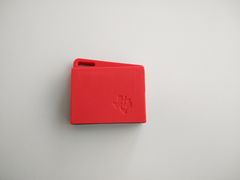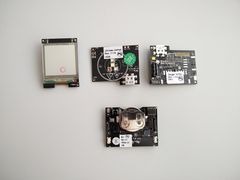Difference between revisions of "IndoorGeoloc2016"
(major update) |
|||
| (10 intermediate revisions by 2 users not shown) | |||
| Line 1: | Line 1: | ||
| + | RICM4 Polytech Grenoble project in Geolocalisation Indoor using geolocating technologies which can be beacons BLE from Apple [[iBeacon]] or [[AltBeacon]]. |
||
| − | Technologies de géolocalisation indoor |
||
| − | Balises (beacon) BLE Apple [[iBeacon]] & [[AltBeacon]] |
||
| − | = Preambule = |
||
= Project presentation = |
= Project presentation = |
||
| − | * Triangularisation of beacons 4.0 bluetooth signals |
||
| − | * Real time display of positions of bluetooth emitting device on an OSM Indoor map |
||
| + | Nowadays, geolocalisation has become a wide spread technology. It is used in order to guide a user from a first point A to another point B, naming it can allow users to have routing help during a travel, such as driving trip or even going to a coffee. In this way, geolocalisation is incredibly well spread outdoor, it's in this case that geolocalisation is the most efficient. |
||
| − | ==Matériel== |
||
| + | But, what about indoor geolocalisation ? Because of the use of satellites and GSM networks to locate an object, it is a harder to use it indoor. Buildings prevent signals to enter making impossible to locate things with those means. And this where our project takes place ! |
||
| + | |||
| + | = Material = |
||
* Android cellphones |
* Android cellphones |
||
* [[STM32 Discovery & Nucleo|STM32 Nucleo]] equiped with shield BLE [[X-NUCLEO-IDB04A1]] |
* [[STM32 Discovery & Nucleo|STM32 Nucleo]] equiped with shield BLE [[X-NUCLEO-IDB04A1]] |
||
| + | * 2 sensorTag 1st generation |
||
| − | * 3 iTag |
||
| + | * 1 sensorTag 2nd generation |
||
| − | * Texas Instrument SimpleLink Multi-Standard SensorTag development kit |
||
| + | * 2 Débug dev pack |
||
| + | * LED audio dev pack |
||
| + | * Watch dev pack |
||
| + | * 1 Genuino 101 |
||
| + | * 2 Intel Quark Microcontroller Dev Kit D2000 |
||
| + | * Emetteur/Récepteur Bluetooth(port série) |
||
<gallery mode="packed-hover" height="180"> |
<gallery mode="packed-hover" height="180"> |
||
| Line 20: | Line 25: | ||
File:Genuino 101.jpg|''[[Genuino 101]]'' |
File:Genuino 101.jpg|''[[Genuino 101]]'' |
||
</gallery> |
</gallery> |
||
| − | |||
| − | == Design Pattern == |
||
| − | |||
| − | [[File:DESIGN_PATTERN_GEOLOC.pdf]] |
||
| − | |||
| − | * Model View Controller : for Android clients |
||
| − | * Remote Procedure Invocation : for Open Street Map procedures' calls |
||
| − | * Publish Subscribe : for beacons emitting information on the network and servers receipts |
||
= Team = |
= Team = |
||
| − | This project is directed by Didier Donsez and designed by Diana Stoian, Quentin Faure, Damien Crastes de Paulet (team leader), Imad-Seddik Arrada. |
+ | This project is directed by Didier Donsez and designed by Diana Stoian, Quentin Faure, Damien Crastes de Paulet (team leader), Imad-Seddik Arrada. The four of us are currently studying in their first year of Polytech master degree. The project is part of the Software Development course. |
| ⚫ | |||
| − | = Progress of the project = |
||
| − | == Week 1 (January 11th - January 17th) == |
||
| − | * Choice of the project |
||
| + | The main goal of the project is to enable people to locate things (objects or people) indoor. Thanks to better fitting technologies in this context, it is now possible to obtain a precise location of an object. |
||
| − | == Week 2 (January 18th - January 24th) == |
||
| + | Using Bluetooth Low Energy technology, objects are located indoor with micro controllers placed in different corners all over the building. Those micro controllers then transmit the data concerning the object to a server which will transform them in order to display them on an OpenStreetMap map. |
||
| − | * Discovery of the project |
||
| − | * Discovery of the already existing technologies |
||
| − | * Test of the given instruments (iTag, STM32...) |
||
| − | * Writing the requirements specifications |
||
| − | == Week 3 (January 25th - January 31st) == |
||
| − | * Writing of the UML diagrams |
||
| − | * Definition of the structure of the project |
||
| − | |||
| − | == Week 4 (February 1st - February 7th) == |
||
| − | * Receipt of the TI Simplelink SensorTag |
||
| − | * Trying to make the sensor work |
||
| − | |||
| − | == Week 5 (February 8th - February 14th) == |
||
| − | * Elaboration of the design patterns to use in the project |
||
| − | * Writting of tests designed to understand the arduino board functionning |
||
| − | * Making the Genuino beacon emit signals is not possible for the moment according to the following website : [https://forum.arduino.cc/index.php?topic=376912.0 arduino.emitting-problems] |
||
| − | We will keep an eye on the evolution of the Genuino emission problem, our project will be designed to allow the treatment of Genuino beacon data. But since time is running out, we will concentrate on the other beacons. |
||
| − | |||
| − | == Week 6 (February 15th - February 21st) == |
||
| − | Before splitting the work into parts for each member of the group, we agreed on the common format of data to use and which attribute is useful between one another. |
||
| − | There are four main parts : |
||
| − | ** Transmission of data from the beacons to the server |
||
| − | ** Extraction and treatment of the received data |
||
| − | ** Emission of the triangulated coordinates to an android client |
||
| − | ** Treatment of the coordinates and display of the result on the client' screen. |
||
| − | |||
| − | /* Ajouter des contraintes-spécificités de chaque partie (ex : protocole MQTT...)*/ |
||
| − | |||
| − | == Week 7 (February 22nd - February 28th) == |
||
| − | /* Break pédagogique |
||
| − | essayer de dire ce que chacun a fait */ |
||
| − | |||
| − | |||
| − | == Week 8 (February 29th - March 6th) == |
||
| − | |||
| − | |||
| − | == Week 9 (March 7th - March 13th) == |
||
| − | |||
| ⚫ | |||
=Liens= |
=Liens= |
||
| Line 85: | Line 42: | ||
** http://enzomolion.github.io/BLEfinder/ |
** http://enzomolion.github.io/BLEfinder/ |
||
** https://github.com/EnzoMolion/BLEfinder |
** https://github.com/EnzoMolion/BLEfinder |
||
| + | * IEEE Registar https://standards.ieee.org/develop/regauth/ |
||
| + | * IBeacon location research https://github.com/jpias/beacon-pfilter-simulation/wiki |
||
Latest revision as of 10:41, 27 January 2017
RICM4 Polytech Grenoble project in Geolocalisation Indoor using geolocating technologies which can be beacons BLE from Apple iBeacon or AltBeacon.
Project presentation
Nowadays, geolocalisation has become a wide spread technology. It is used in order to guide a user from a first point A to another point B, naming it can allow users to have routing help during a travel, such as driving trip or even going to a coffee. In this way, geolocalisation is incredibly well spread outdoor, it's in this case that geolocalisation is the most efficient. But, what about indoor geolocalisation ? Because of the use of satellites and GSM networks to locate an object, it is a harder to use it indoor. Buildings prevent signals to enter making impossible to locate things with those means. And this where our project takes place !
Material
- Android cellphones
- STM32 Nucleo equiped with shield BLE X-NUCLEO-IDB04A1
- 2 sensorTag 1st generation
- 1 sensorTag 2nd generation
- 2 Débug dev pack
- LED audio dev pack
- Watch dev pack
- 1 Genuino 101
- 2 Intel Quark Microcontroller Dev Kit D2000
- Emetteur/Récepteur Bluetooth(port série)
Team
This project is directed by Didier Donsez and designed by Diana Stoian, Quentin Faure, Damien Crastes de Paulet (team leader), Imad-Seddik Arrada. The four of us are currently studying in their first year of Polytech master degree. The project is part of the Software Development course.
Summary
The main goal of the project is to enable people to locate things (objects or people) indoor. Thanks to better fitting technologies in this context, it is now possible to obtain a precise location of an object. Using Bluetooth Low Energy technology, objects are located indoor with micro controllers placed in different corners all over the building. Those micro controllers then transmit the data concerning the object to a server which will transform them in order to display them on an OpenStreetMap map.
Liens
- Beacons, 22 utilisations hors magasin à connaître avant 2015
- VT2015 Geolocalisation Indoor
- Enzo Molion, Stage d'excellence, Université Joseph Fourier, 2015
- IEEE Registar https://standards.ieee.org/develop/regauth/
- IBeacon location research https://github.com/jpias/beacon-pfilter-simulation/wiki



